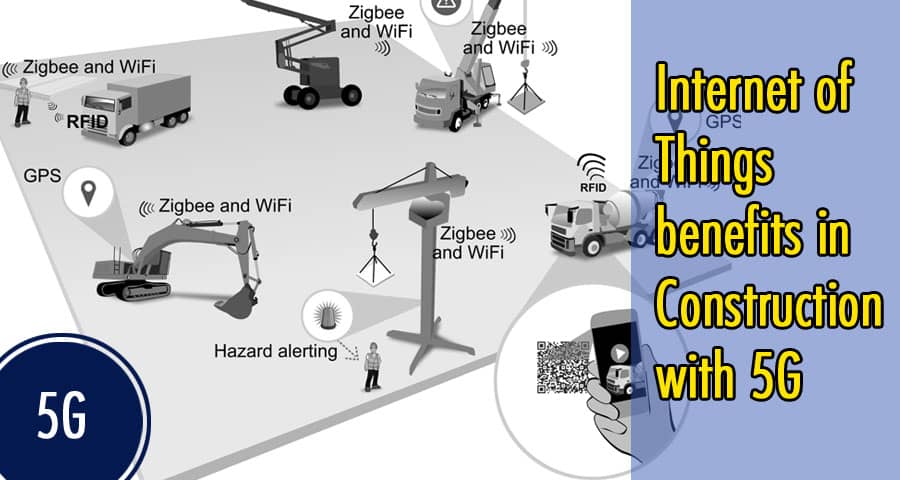Internet of Things benefits in Construction with 5G

The integration of Internet of Things (IoT) with 5G technology has created a significant impact on various industries. In the construction industry, IoT and 5G have opened up new possibilities to improve efficiency, safety, and productivity. This article will discuss the benefits of IoT in construction with 5G technology.
Introduction
The construction industry is known for its slow adoption of new technologies. However, the integration of IoT and 5G technology has the potential to revolutionize the industry. The real-time data transmission capability of 5G networks and the ability of IoT devices to collect and analyze data can help construction companies to make informed decisions, reduce errors, and save costs.
Increased Efficiency
IoT devices can monitor and track equipment, tools, and materials in real-time. With the help of 5G networks, the data collected by these devices can be transmitted instantly, enabling construction companies to optimize their processes and workflows. IoT devices can also help to predict maintenance issues before they occur, preventing downtime and reducing repair costs.
Improved Safety
Construction sites can be dangerous places, with numerous hazards that can cause accidents. IoT devices can help to monitor the safety of workers and detect potential hazards, such as gas leaks or structural weaknesses. With 5G networks, this data can be transmitted instantly, enabling site managers to take action quickly to mitigate risks.
Quality Control
IoT devices can monitor the quality of materials used in construction projects, such as concrete or steel. With the help of sensors and real-time data transmission, construction companies can ensure that materials meet quality standards and are used efficiently. This can help to prevent costly mistakes and improve the longevity of the finished project.
Cost Savings
IoT devices can help construction companies to save costs in various ways. By monitoring equipment and predicting maintenance issues, companies can reduce downtime and repair costs. IoT devices can also help to optimize workflows, reducing labor costs and improving efficiency. Additionally, by monitoring the quality of materials, construction companies can avoid costly mistakes and rework.
Remote Monitoring
IoT devices can be used to remotely monitor construction sites and equipment. This can be particularly useful for large construction projects or those located in remote areas. With the help of 5G networks, remote monitoring can be done in real-time, enabling site managers to make informed decisions and take action quickly.
Sustainable Construction
IoT devices can help to make construction projects more sustainable by monitoring energy usage, waste management, and water usage. By optimizing these processes, construction companies can reduce their environmental impact and save costs.
Improved Communication
Communication is essential in the construction industry, particularly on large projects with numerous stakeholders. IoT devices can help to improve communication by providing real-time updates on project progress, equipment status, and potential issues. With 5G networks, these updates can be transmitted instantly, enabling stakeholders to make informed decisions.
Enhancing Productivity
IoT devices can help to enhance productivity by providing real-time data on the status of equipment, materials, and workers. This can help construction companies to optimize their processes and workflows, reducing downtime and improving efficiency.
Predictive Maintenance
IoT devices can help to predict maintenance issues before they occur, preventing downtime and reducing repair costs. By monitoring equipment and detecting potential issues, construction companies can take action proactively, avoiding costly repairs and downtime.
Real-Time Data Analysis
IoT devices can collect vast amounts of data in real-time. With the help of 5G networks, this data can be transmitted instantly, enabling construction companies to analyze it and make informed decisions. Real-time data analysis can help to identify trends and patterns, improving decision-making and reducing errors.
Risk Management
Construction projects can be risky, with numerous potential hazards and risks IoT devices can help construction companies to manage risks by monitoring safety hazards, detecting potential issues, and providing real-time updates. With the help of 5G networks, risk management can be done in real-time, enabling site managers to take action quickly to mitigate risks.
Improved Project Planning
IoT devices can help to improve project planning by providing real-time data on project progress, equipment status, and potential issues. With the help of 5G networks, this data can be transmitted instantly, enabling stakeholders to make informed decisions and adjust project timelines and budgets accordingly.
Enhanced Collaboration
IoT devices can help to enhance collaboration between stakeholders in construction projects. By providing real-time updates on project progress, equipment status, and potential issues, IoT devices can facilitate communication and collaboration between project teams.
Increased Flexibility
IoT devices can help construction companies to be more flexible by providing real-time updates on project progress, equipment status, and potential issues. With the help of 5G networks, construction companies can make informed decisions quickly and adjust project timelines and budgets accordingly.
Conclusion
The integration of IoT and 5G technology has brought numerous benefits to the construction industry, including increased efficiency, improved safety, enhanced collaboration, and cost savings.
FAQs
What is IoT in construction?
IoT in construction refers to the integration of devices and sensors to monitor equipment, materials, and processes in real-time.
How does 5G benefit the construction industry?
5G benefits the construction industry by providing real-time data transmission capability, enabling construction companies to make informed decisions quickly.
What are the benefits of IoT in construction?
The benefits of IoT in construction include increased efficiency, improved safety, cost savings, quality control, and enhanced productivity.
How does IoT help with risk management in construction?
IoT helps with risk management in construction by monitoring safety hazards, detecting potential issues, and providing real-time updates to site managers.
How can IoT and 5G technology improve project planning in construction?
IoT and 5G technology can improve project planning in construction by providing real-time data on project progress, equipment status, and potential issues, enabling stakeholders to make informed decisions and adjust project timelines and budgets accordingly.
